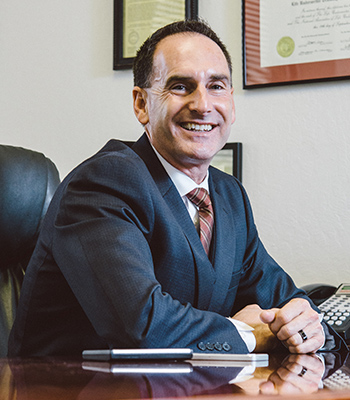Lesson learned: Risk management comes first
Lesson learned: Risk management comes first

Jeff Pesta, LUTCF • San Jose, CA
LPL Financial
Read full biography below
Relying on market “predictions” can lead to undisciplined decision-making. Applying algorithmic strategies—designed for asset protection—can smooth out long-term volatility and returns.
Proactive Advisor Magazine: Jeff, what initially prompted your interest in active investment management?
 In the late 1990s and early 2000s, I became very frustrated after hearing from economists, mutual fund managers, and assorted other investment professionals who were offering expert opinion and advice at seminars and conferences. They were sincere and well-intentioned, but their messages were often off the mark in terms of what was really happening with the economy or the markets.
In the late 1990s and early 2000s, I became very frustrated after hearing from economists, mutual fund managers, and assorted other investment professionals who were offering expert opinion and advice at seminars and conferences. They were sincere and well-intentioned, but their messages were often off the mark in terms of what was really happening with the economy or the markets.
In my opinion, more often than not, what they were positioning as ways to help clients make investment decisions turned out to be the exact opposite of what ultimately was the right direction. My frustration was hearing what seemed to be a great story, explanation, or rationale and then going back to try to manage investments based on that—and not having success, left feeling very foolish in front of my clients.
In the market declines surrounding 9/11 and the dot-com bust, supposedly noncorrelated assets appeared to be correlated. Everything basically went down hard, though some asset classes or sectors were far worse than others.
I did my best to help manage clients’ investments through that difficult period, but it was very unwieldy and inefficient making multiple moves across asset classes and alternatives for my clients. I decided fairly quickly there had to be a better way to manage investments than to count on market “predictions” or to think a standard diversified, asset-allocation approach would afford the portfolio protection that is needed.
Where did that lead your investment thinking?
I put a lot of time into doing my own research on investment theory, technical analysis, and portfolio allocations. In effect, I became an “active manager” to the best of my ability on behalf of my clients.
I became very knowledgeable and fairly adept at money management, but it goes back to efficiency and my own time management. Managing investments across diverse client needs, risk profiles, and objectives is a full-time responsibility best put in the hands of the real experts. I have become a strong advocate of third-party active investment management.
I conduct my own due diligence of managers, in addition to that performed by LPL Financial, and look for those managers who I think are best-in-class. Based on everything I know about sound investing in today’s markets, these managers have the ability to put together the portfolio allocations and trading implementation with the software, algorithms, staff, and models to manage money the way I think it should be managed across my client base. Yes, there are fees involved, but I think you get what you pay for, and it is well worth it.
“There is a better way to manage investments than counting on market predictions or a standard asset-allocation approach.”
How do you go about selecting third-party managers?
The overall criteria are pretty simple in concept, but the investigation is not. I need answers to two basic questions: (1) Is their methodology well-developed and are their strategies in sync with the objectives I want for my clients? (2) Can they implement the way they say they will? As part of this, I tend to drive the process in terms of researching and interviewing potential managers. I also want to speak to their staff—the people actually developing the portfolio models and trading strategies. It is a very rigorous process.
What is the benefit to your clients?
 Most of my clients are planning for retirement or already retired. The primary benefit is the risk-management element of active management—how does the manager’s approach perform during down markets? My clients cannot afford, literally and emotionally, to sustain 30%, 40%, or 50% drawdowns to their portfolios. In my opinion, they also are not well-served by a buy-and-hold approach that essentially went nowhere.
Most of my clients are planning for retirement or already retired. The primary benefit is the risk-management element of active management—how does the manager’s approach perform during down markets? My clients cannot afford, literally and emotionally, to sustain 30%, 40%, or 50% drawdowns to their portfolios. In my opinion, they also are not well-served by a buy-and-hold approach that essentially went nowhere.
I explain to clients that active management performs best when there is a clearly defined trending market—either a bull trend or a bear trend. The strategies we use will not catch the totality of every move in either type of market, but they are formulated to help in better managing volatility. The difference in performance can be especially magnified in very poor market years, where the return spread between an active approach and a passive approach has been very significant. Over the long term, we should see those factors play out in the bottom-line growth of clients’ portfolios.
Do you use active money management for most of your clients?
I do not want to generalize too much, as all of my clients have their own unique needs and objectives. I think one of my strengths is drilling down and understanding those needs and building a plan that seeks to increase the probability of success. That plan can have some different elements, including things like annuities for an income stream.
But one of the benefits of using third-party managers is that they can accommodate both very conservative and more aggressive investors, blending combinations of strategies and asset classes. Using various tools provided by our managers can help clients understand an expected range of performance over a relatively extended time period.
Giving clients the knowledge that we are trying to put probabilities in their favor is a very effective and reassuring message for my practice.
 Jeff Pesta entered the financial-services industry 22 years ago with one goal: Helping people better understand and navigate the world of personal finance. With a vision to build his firm based on trust and respect, Mr. Pesta firmly believes he has far exceeded that objective. Mr. Pesta took over the tax practice his parents first established in the 1970s and has expanded the firm to offer a wide range of financial and investment services through LPL Financial.
Jeff Pesta entered the financial-services industry 22 years ago with one goal: Helping people better understand and navigate the world of personal finance. With a vision to build his firm based on trust and respect, Mr. Pesta firmly believes he has far exceeded that objective. Mr. Pesta took over the tax practice his parents first established in the 1970s and has expanded the firm to offer a wide range of financial and investment services through LPL Financial.
Mr. Pesta graduated from San Jose State University with an emphasis in finance and economics. He holds Series 7 and 66 registrations and is a licensed agent for several insurance companies. Mr. Pesta has extensive experience advising individuals, families, and corporations and feels his specialty is breaking down complex issues with a concise approach to address financial concerns and opportunities.
“Putting my clients ahead of everything else has been the foundation for my business,” Mr. Pesta says. “It has enabled me and my firm to enjoy many years of success in this community.”
Mr. Pesta and his wife, Lisa, reside in Gilroy, California. They have 18-year-old twin boys, a 24-year-old son, and a 23-year-old daughter, all of whom are “hard at work” with college or graduate studies in California.
Disclosure: Jeff Pesta is a registered representative with and securities and advisory services offered through LPL Financial, a registered investment advisor. Member FINRA & SIPC. Investing involves risk, including potential loss of principal. No strategy ensures success or protects against a loss. Pesta & Pesta Tax Preparation is a separate unaffiliated entity from LPL Financial.
Photography by Jay Watson

